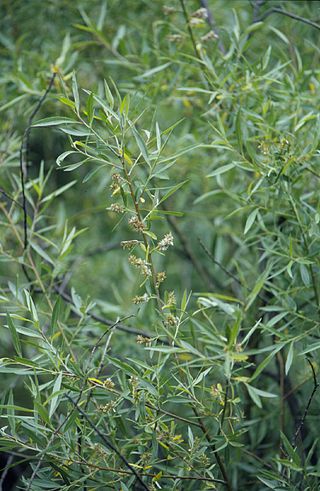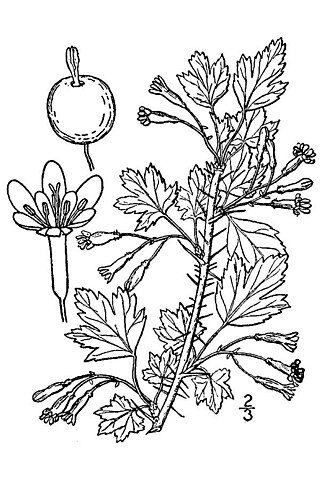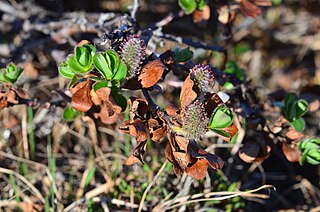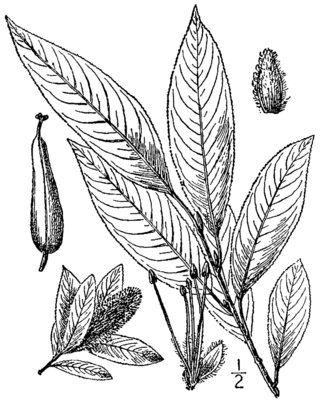
Pinus contorta, with the common names lodgepole pine and shore pine, and also known as twisted pine, and contorta pine, is a common tree in western North America. It is common near the ocean shore and in dry montane forests to the subalpine, but is rare in lowland rain forests. Like all pines, it is an evergreen conifer.

Salix scouleriana is a species of willow native to northwestern North America. Other names occasionally used include fire willow, Nuttall willow, mountain willow, and black willow.
Salix barrattiana is a species of flowering plant in the willow family known by the common name Barratt's willow. It is native to North America, where it is distributed across Alaska and western Canada, with also a few populations in Montana and Wyoming. These disjunct populations are probably relics from a time when the climate was colder. The southernmost population is technically in Wyoming, but it is located at the Montana state line and it is limited to one clone of all-staminate plants within an area of 100 square meters (1,100 sq ft) in a high-elevation habitat.

Salix geyeriana is a species of willow known by the common names Geyer's willow, Geyer willow and silver willow. The type specimen was collected by the botanist Karl Andreas Geyer, for whom it was named. Its conspicuous, yellow flowers begin to bloom as early as March, to as late as the end of June.

Arctostaphylos rubra is a species of flowering plant in the heath family and the genus Arctostaphylos, the manzanitas and bearberries. Common names include red fruit bearberry, alpine bearberry, arctic bearberry, red manzanita, and ravenberry. It is native to Eurasia and northern North America from Alaska through most of Canada to Greenland. There is also one population in the contiguous United States, located in the Absaroka Mountains of Wyoming.

Linanthus pungens is a species of flowering plant in the phlox family known by the common names granite prickly-phlox and granite gilia. It is native to western North America from British Columbia to Baja California and east to Montana and New Mexico.
Elymus macrourus is a species of grass known by the common names tufted wheatgrass and thickspike wildrye. It is native to northwestern North America in Alaska, Yukon, and the Northwest Territories. It is also present in eastern Siberia.

Hilaria mutica, synonym Pleuraphis mutica, is a species of grass known by the common name tobosa, or tobosa grass. It is native to Northern Mexico, and the Southwestern United States, in Arizona, New Mexico, Oklahoma, and Texas.

Ribes oxyacanthoides is a species of flowering plant in the gooseberry family known by the common name Canadian gooseberry. Its various subspecies have common names of their own. It is native to North America, where it occurs in Alaska through much of Canada and the western and north-central United States.

Salix alaxensis is a species of flowering plant in the willow family known by the common names Alaska willow and feltleaf willow. It is native to northern North America, where it occurs throughout Alaska and northwestern Canada.

Salix arbusculoides is a species of flowering plant in the willow family known by the common name little tree willow. It is native to northern North America, where its distribution extends across Alaska and most of Canada.

Salix brachycarpa is a species of flowering plant in the willow family known by the common names barren-ground willow, small-fruit willow and shortfruit willow.
Salix fuscescens is a species of flowering plant in the willow family known by the common name Alaska bog willow. It is native to northern North America, where it occurs throughout much of Alaska and across northern Canada. It is also present in Eurasia.

Salix glauca is a species of flowering plant in the willow family known by the common names gray willow, grayleaf willow, white willow, and glaucous willow. It is native to North America, where it occurs throughout much of Alaska, northern and western Canada, and the contiguous United States south through the Rocky Mountains to northern New Mexico. It can also be found in Greenland, northwestern Europe, and Siberia.

Salix hastata is a species of flowering plant in the willow family, known by the common name halberd willow. It has an almost circumpolar distribution, occurring throughout the northern latitudes of the Northern Hemisphere, most frequently found near the coast of the Arctic Ocean. In Alaska, it occurs in the north and in the central mountains. It also occurs in northwestern Canada, and in Norway and Russia, as well as various alpine or mountainous areas of Eurasia.
Salix monticola is a species of flowering plant in the willow family known by the common names mountain willow, cherry willow, serviceberry willow, and park willow. It is native to the United States, where it occurs in the Rocky Mountains region from Wyoming to Arizona and New Mexico. It also occurs in Alaska and parts of Canada.
Salix myrtillifolia is a species of flowering plant in the willow family known by the common name blueberry willow. It is native to northern North America, where it occurs in Alaska and much of Canada.

Salix pulchra is a species of flowering plant in the willow family, known by the common names diamondleaf willow, tealeaf willow, and thin red willow. It is native to northern North America, where it occurs in Alaska, Yukon, the Northwest Territories, and Nunavut. The species is also found in northern British Columbia, and occurs in Russia.

Salix richardsonii is a species of flowering plant in the Salicaceae, or willow family. It is known by the common names Richardson's willow and woolly willow. It is native to Russia and northern North America, where it occurs in Alaska and northern Canada. Some authorities consider it to be a subspecies, Salix lanata subsp. richardsonii(Hook.) A. K. Skvortsov rather than a species itself.

Salix serissima is a species of flowering plant in the willow family known by the common names autumn willow and fall willow. It is native to North America, where it is distributed across much of Canada and the northern contiguous United States.
















